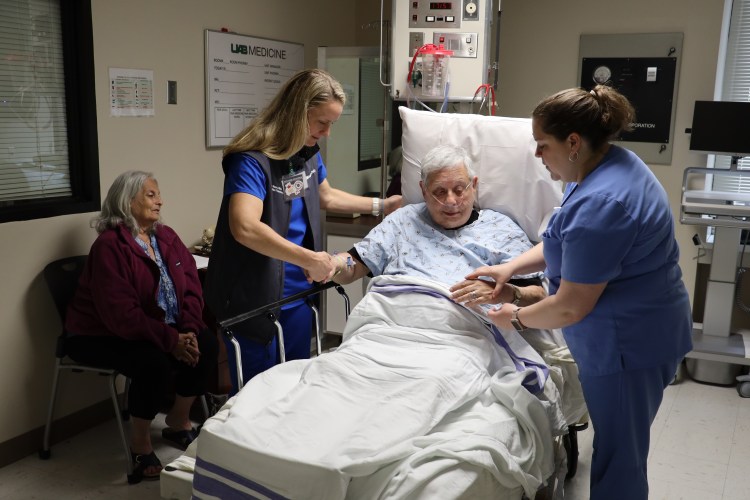Clinical Simulation welcomes Geriatric Scholars

UAB Clinical Simulation offers experiences that can benefit all members of the health-care team.
UAB’s Geriatric Scholar program is a prime example, featuring an interprofessional group of learners spanning UAB Medicine—nurses, social workers, pharmacists, nutritionists, advanced practice providers, care managers, chaplains and more.
Administered by the Department of Interprofessional Practice and Training (DIPT), the Geriatric Scholar Program is a competitive, hospital-based professional development and clinical recognition program designed to develop champions in age-friendly care.
According to DIPT, the program provides learning opportunities through classroom work, clinical rotations, interactive learning and simulation training, allowing health-care professionals to formally develop an in-depth knowledge of caring for hospitalized older adults, while implementing evidence-based age-friendly principles.
A crucial part of the curriculum is applying lessons from the classroom to a clinical setting through simulation.
Enter UAB Clinical Simulation, which hosts the simulation component of the scholars’ training.
“The beauty of simulation is that the learners get to apply content they’ve covered in the didactic portion of the program,” said David James, DIPT program development manager and clinical assistant professor in the UAB School of Nursing. “And we use standardized patients.”
A standardized patient (SP) is a person who is trained to portray a patient, demonstrating his or her medical history, physical exam findings and emotional responses to provide learners with realistic experience.
For the Geriatric Scholars simulations, SPs helped participants practice the Four Ms of Age-Friendly Care—What Matters, Safe Mobility, Mentation and Medication. The learners worked in small multidisciplinary teams to traverse a series of scenarios, after which they participated in debriefings to review and reflect on takeaways from each experience.
In this case, learners received feedback from standardized patients, as well as their facilitators.
“The advantage here is the SPs provide the scholars with feedback,” James said. “Oftentimes, due to power dynamics, patients with families present may not feel safe or empowered. Here, the scholars received feedback about their personal interactions and how the patients and their families felt, which is a really valuable part of their training.”
James noted that such interprofessional simulations showcase how participants learn from and with each other.
“Learners get to reflect on their own performances and learn from their peers,” he said. “In debriefing, they’re able to discuss best practices they observed with their teammates and share those across the room. It’s incredibly impactful.”
For more information on how your interprofessional team can benefit from simulation, email UAB Clinical Simulation at simulation@uabmc.edu. To learn more about DIPT and the Geriatric Scholar Program, visit here or email cmiranda@uabmc.edu.




0 Comments